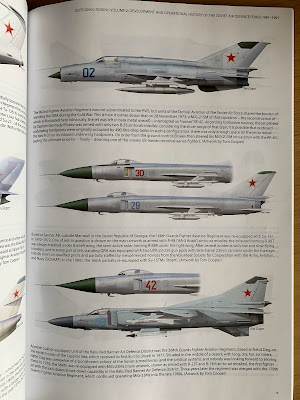The first chapter gives a run down of the PVO (Soviet Air Defence Force), its organisation and the surveillance, control and early warning systems it employed. Chapter two focuses on the developments in surface to air and anti-ballistic missile technology throughout the period covered - the amount of effort put into fielding highly advanced technology for the time is impressive, despite the obvious effects such spending would have on the wider Soviet economy - but that's a tale for another time.
Chapter three covers the aircraft pushed into service and the various missile systems they used. As a military aviation enthusiast, I do like the design of early jets, and the range of Soviet machines do, at least for me, have a certain je ne sais quoi. From the svelte Sukhoi Su-11 to the more sedate looking Yakolev Yak-25, there are some striking looking aircraft here. The purposeful Yak-28 gets some love, as does the incomparable (and might fine) Tupolev Tu-128 - now that is how you build a long-range interceptor!
Chapters four and five cover polar and border intercepts, whilst chapter six proves that there is nothing new in this world as the Soviets dealt with many a balloon incursion long before it became fashionable to shoot down the things using an almost priceless F-22 and an expensive AIM-9X.
Chapter seven is a more sombre read, taking on the subject of airline intercepts and, of course, covering the infamous shoot down of KAL Flight 007 in 1983. There were other intercepts, but none ended in the tragedy that engulfed that Korean Air Lines 747.
Chapter eight is all about the defections that the service suffered, nine features the successful shoot downs of valid targets, whilst ten highlights possibly the most absurd missed interception of the Cold War, Mathias Rust's jolly boys day out to Moscow. It wasn't the only light aircraft shenanigans, as you'll find out here. The final chapter relates the closing period of the Cold War.
There are a couple of appendices: Commander of the PVO between 1945 and 1991, and a chronological list of the PVO's aerial victories, of which there were many more than I expected.
As always with a Helion & Co publication, there are numerous photographs, maps and diagrams, all of which are high quality - taking into account the nature of the original imagery and its age, whilst the central artwork section has some lovely profiles of the aircraft featured within. For those who, in the best traditions of the Federal Network infomercials, want to know more, there is a cracking bibliography to investigate too.
In the same vein as volume one, this is a well written, highly informative and interesting look at how the Soviet Union approached air defence through the Cold War. With plenty to read, look at and follow up on, they're a very worthy pair on the subject, and of much benefit to history fans and those who may wish to put something on the table. You can buy this (and the preceding volume) directly from Helion and Co here, as well as follow the publisher on Twitter here.




No comments:
Post a Comment